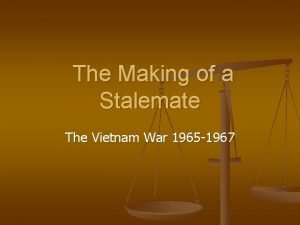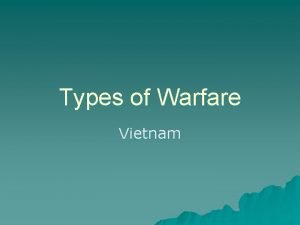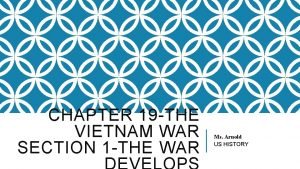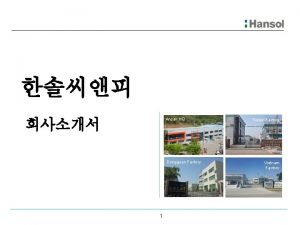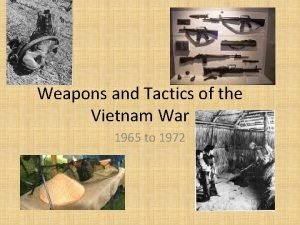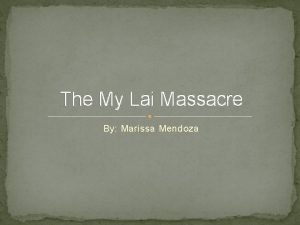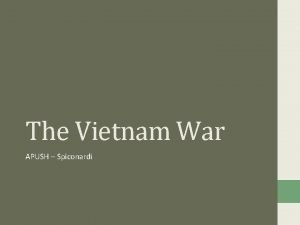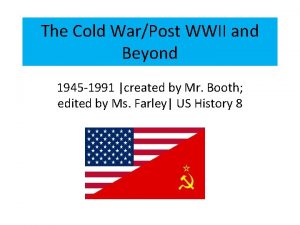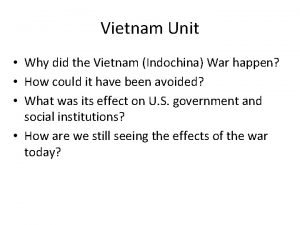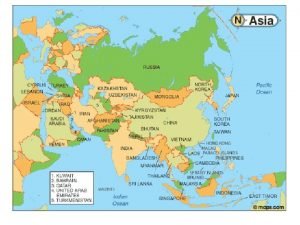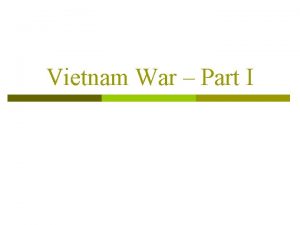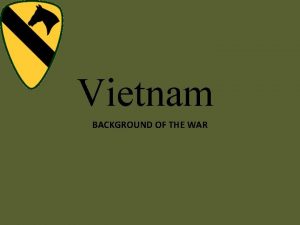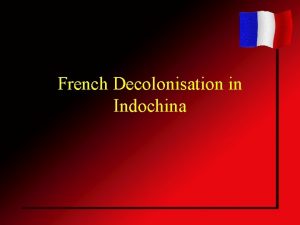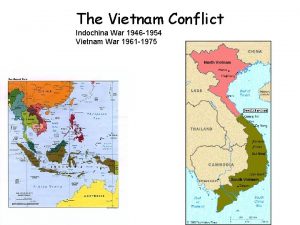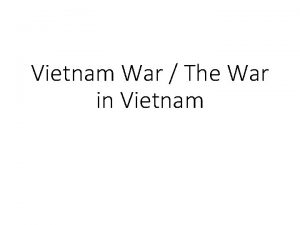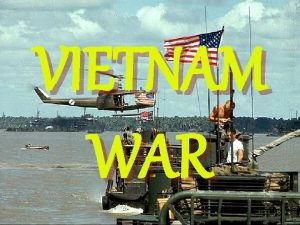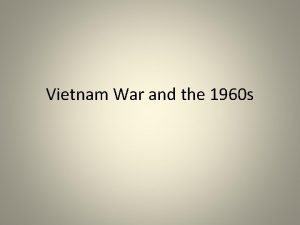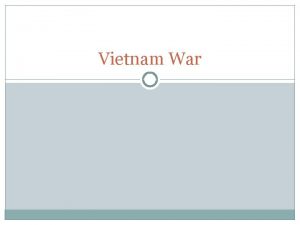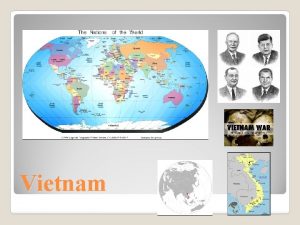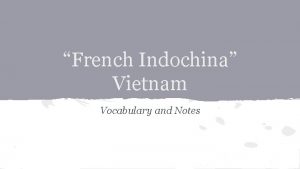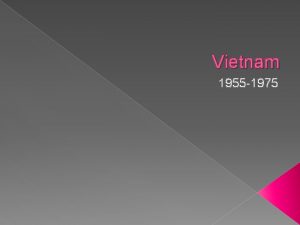The Vietnam War French Indochina War Ho Chi
















- Slides: 16

The Vietnam War • • • French Indochina War Ho Chi Minh – independence from foreign rule America gives aid to France Vietminh drive out French Geneva Accords • Divide Vietnam along 17 th parallel • Ho Chi Minh leads the North (Hanoi) • Ngo Dinh Diem leads the South (Saigon)

“If ever the tiger pauses, the elephant will impale him on his mighty tusks. But the tiger will not pause, and the elephant will die of exhaustion and loss of blood. ”

• 1956 Elections to unify Viet Nam cancelled • Economic and military aid to South Viet Nam • Ngo Dinh Diem • Corrupt • Restricted Buddhist practices • No land redistribution • 1957 Viet Cong begins attacks • Ho Chi Minh supplies Viet Cong


• Kennedy – 1963 16, 000 advisors • America stages coup November 1, 1963 • Prior to death, announces intent to withdraw • Lyndon Baines Johnson escalates the war • Tonkin Gulf Resolution • “all necessary measures to repel any armed attack against the forces of the United States and to prevent further aggression. ”

Progression of the war • • • French vs. Vietminh – French surrender at Dien Bien Phu(1954) Kennedy sends advisors to Vietnam Gulf of Tonkin incident (1964) • US ships patrolling gulf collecting information • Secret raids into North Vietnam • North Vietnamese fire torpedo at USS Maddox • USS Maddox returns fire • Two days later with low visibility crew claims more attacks • Later deny any gunfire • Alleged attack leads to Tonkin Gulf Resolution August

Goals, strategies, tactics • • • America Military struggle Contain communism Search and destroy Air strikes Napalm Agent Orange • • • North Vietnamese Struggle for their existence No foreign control Ambush/guerrilla warfare Tunnels Booby traps Civilians “We had to destroy the town in order to save it”

Progression of the war • Operation Rolling Thunder (February 1965)– bombing campaign • June 1965 – 50, 000 combat soldiers in Vietnam • 61% of public supports the war and Johnson’s foreign policy • End of 1965 over 180, 000 Americans sent to Vietnam • 1967 – 500, 000 troops in Vietnam • 1967 Johnson needs tax increase to fund war – must trade $ for domestic programs • 1968 United States morale begins to sink • Soldiers turn to alcohol, weed, and other drugs • Living room war – televised • “Credibility gap” – Reports not the same as reality

THE TET OFFENSIVE • • • January 30 – New Year Holiday Week long truce announced Villages flock to cities Simultaneous surprise attack by Vietcong Lasts for a month People start to turn against the war Militarily – a success 32, 000 dead vs. 3, 000 Psychologically - Vietcong are everywhere!!! Can’t stop them Politically – February 1968 60% of public does not support Johnson https: //www. history. com/topics/vietnam-war/tet-offensive

https: //www. youtube. com/watch? v=arf. Md_ar 91 o

MY LAI MASSACRE • • • November 1969 - Reporter Seymour Hersh March 16, 1968 Lt. William Calley Jr. Massacred innocent civilians Searching for Vietcong Rounded up and shot 500 villagers (women, children, elderly) • The US troops are viewed as “Baby killers” • Following orders • Calley is convicted and imprisoned https: //www. history. com/topics/vietnam-war/my-laimassacre

ENDING THE WAR • • March 1972 – North Vietnamese attack Bombings halt the North Vietnamese Negotiations continue then break down December 1972 – “Christmas bombing” (100, 000+ bombs over 11 days) • January 27, 1973 – Agreement on ending the war and Restoring Peace in Vietnam • North Vietnamese troops remain in South Vietnam • US will respond with ‘full force’ if peace agreement is violated

ENDING THE WAR • • • March 29, 1973 – Last of troops withdraw Within months peace agreement collapses March 1975 North Vietnam invades the South Thieu asks for help (we send $ not troops) April 30, 1975 Saigon falls South Vietnam surrenders

The Legacy of Vietnam • Violence and protests/Divided country • Vets are poorly treated/ suffer from PTSD • Congress repeals the Gulf of Tonkin Resolution (12/31/70) • Deep mistrust of government • Pentagon Papers – leaked documents • Government had drawn up plans to enter the war as Johnson promised not to send troops • No plan to end the war

The Legacy of Vietnam • Vietnam unified under communist regime • 1. 5 million people flee including ‘boat people’ • Khmer Rouge led by Pol Pot in Cambodia • 1 million Cambodians executed • Abolish draft • 26 th Amendment (1971) Voting Age is lowered to 18 • War Powers Act • President must notify Congress within 48 hours of sending troops • Troops can only remain for 90 days w/o declaration of war

1. Did American presidents have good reasons to fight a war in Vietnam? 2. Can domestic protest affect the outcome of war? 3. Did the war in Vietnam bring a domestic revolution to the United States? 4. Should the United States have gotten involved in the Vietnam conflict? Explain your position using evidence.
 Korean war vietnam war venn diagram
Korean war vietnam war venn diagram Presidential and congressional reconstruction venn diagram
Presidential and congressional reconstruction venn diagram Bàn tay mà dây bẩn
Bàn tay mà dây bẩn đổi địa chỉ logic sang địa chỉ vật lý
đổi địa chỉ logic sang địa chỉ vật lý Chi chi nnn
Chi chi nnn Chi chi tg tf
Chi chi tg tf Chi domanda lavoro
Chi domanda lavoro Did the vietnam war end in a stalemate
Did the vietnam war end in a stalemate Vietnam war traps
Vietnam war traps Chapter 19 the vietnam war
Chapter 19 the vietnam war Vietnam war
Vietnam war Us weapons vietnam war
Us weapons vietnam war Marissa lai
Marissa lai Vietnam war apush
Vietnam war apush Vietnam war at home webquest answers
Vietnam war at home webquest answers Reason for vietnam war
Reason for vietnam war Operation rolling thunder cold war
Operation rolling thunder cold war







